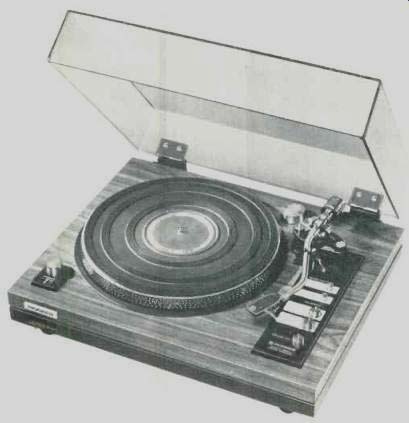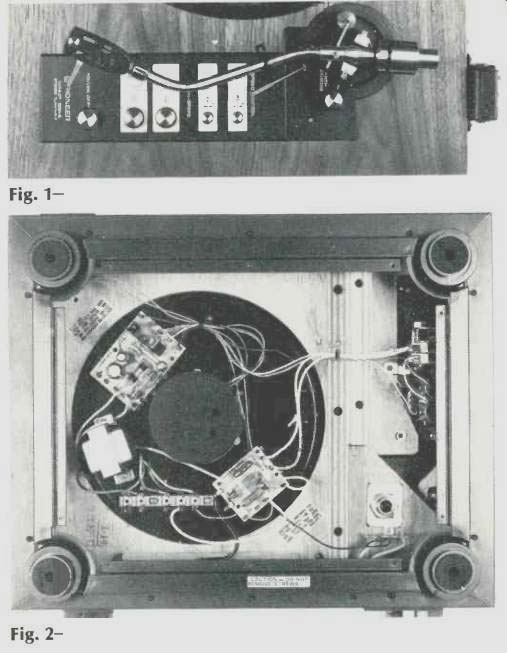
MANUFACTURERS SPECIFICATIONS
Speeds: 33-1/3 and 45 rpm.
Wow and Flutter: 0.05% (WRMS) or less.
Rumble: Better than 60 dB.
Platter: 31 cm., aluminum alloy.
Effective Arm Length: 224 mm.
Tracking Error: +3,-1 deg.
Usable Cartridge Weight: 4 to 32 gms.
Dimensions: 18-7/8 in. W. x 16 in. D. x 7 1/4 in. H.
Weight: 24 lbs. 4 oz.
Price: $299.95.
The Pioneer PL-71 is one of the most elegant, professional looking turntables we have yet tested, and its performance is top rate, as we will see later. Unlike most units, the motor panel is made of wood. The controls are all located on a handsome metal subpanel mounted on the right-hand side.
From the front, there are three push-buttons for on/off, 33 1/3 or 45 rpm; then come two small rotary controls for speed variation (one for each speed) and, next to the arm base, is a long cue lever. The arm itself is a beautifully made S-type with counterweights, and there are adjustments for anti skating, stylus force, lateral balance, arm height, and overhang. The anti-skating control is mounted on an extension to the arm base and is calibrated 0 to 4 grams, as is the tracking force dial. This is in the form of a ring on the rear of the tone arm (see Fig. 1). The reference mark is on the tone arm, and the dial is set to zero until the arm is balanced in the usual manner. The lateral balance is a little unusual, consisting of an angled bar fixed to the arm just in front of the pivot. A weight is placed on the end and a set-screw locks the bar on the arm so that no further adjustment is required.
The cartridge shell is held by a quick-release collar, and the cartridge is positioned for optimum overhang by using a gauge which doubles as the 45-rpm adaptor.
The motor is a d.c. servo type, direct-coupled to the turntable spindle so there is no belt, idler wheel or gears. It is driven by a single power transistor in a feedback circuit working at about 30 volts. The 3-lb. platter has strobe markings on the rim, and illumination is provided by a neon tube called a strobo-light which is mounted at the front left corner. Direct-drive systems have inherently low wow and flutter, while the servo control helps to maintain long term stability. The motor and pickup arm are not spring mounted, but acoustic feedback is prevented by elaborate shock absorbers built into the four mounting feet.

Fig. 1-Close-up of arm.
Fig. 2-View from beneath.
Measurements
No trouble was experienced in mounting the phono cartridge which was my standard Shure V-15 III. Balancing and setting the other adjustments are fully described in the well illustrated instruction manual so that even an absolute beginner should have no difficulty. The first test for wow and flutter measured a shade over 0.05% using the DIN standard. Rumble was exceptionally low at-65 dB ARRL. Speed variation was +4 to-3.5°/o at 45 rpm and +3 to-3.6% at 33-1/3. No change was detected when the line voltage was varied between 90 and 130 volts-a tribute to the servo system. (Incidentally, the PL-71 works just as well on a 50-Hz supply-no capstan or other change is necessary. There are connections for 200 to 240 volt operation.) The stylus force gauge was extremely accurate-certainly within 3%-and arm resonance with the Shure V-15 Ill came out at just under 8 Hz with a negligible 3-dB rise. Lateral and vertical bearing friction was too low to be measured accurately, and tracking error was less than 0.5 degrees per inch. Cable capacitance was found to be less than 100 pF, so some of the tests were made with a CD-4 cartridge, an Audio-technica AT-20.
Use Tests
The PL-71 was used for several weeks, mainly with CD-4 records, and I must say I was very impressed. I did miss an automatic stop, but apart from that I have no criticisms to make. Optimum tracking force for the Audio-technica AT 20 was 1 1/4 grams and just over 1 gram for the Shure V15 Mk III. Actually, many records could be played at under one gram but I invariably adjust for the difficult ones or use the Shure test disc. Many people do not realize that too low a tracking force can do as much damage as one that is too high! What about the anti-skating control? Well, optimum position was found to be a little higher than the tracking force but it was not unduly critical. The cue lift is nicely damped with no side-play, and all the controls worked smoothly. Once the speed control was set, no readjustment was necessary--the speed remained constant--right on the nose. The motor itself is exceptionally quiet, and taken all round, I would put the PL-71 in the highest class-even the most fastidious audiophile will not be disappointed.
George W. Tillett(Audio magazine, Feb. 1976)
= = = =
Also see:
Pioneer Model 510A Direct-Drive Manual Turntable (Equip. Profile, Aug. 1977)
Pioneer PL-7 Turntable (Aug. 1982)
Pioneer PL-630 direct-drive turntable (ad, Dec. 1979)
Pioneer SL-518 direct-drive turntable technology (ad, Jan. 1979)